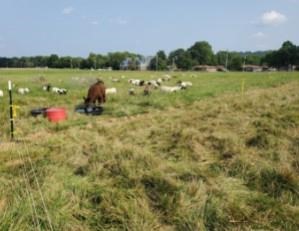By Ryan McGeeney
It doesn’t take a champion mutton buster to know that sheep graze differently from cattle, although the underlying forage base is typically the same.

HOME ON THE RANGE — Recently grazed paddock (right) and the paddock sheep including a guard llama were moved to the same day, with complete fence setup still in progress. Notice the relative tall canopy in the already grazed paddock to ensure minimum exposure to parasites and as much leaf material as possible for a speedy regrowth. (Image courtesy Dirk Philipp.)
Dirk Philipp, associate professor of animal science for the University of Arkansas System Division of Agriculture, recently led an Arkansas Agricultural Experiment Station research team in efforts to restore an overgrazed novel-endophyte tall fescue pasture to provide sheep access to fresh forage during the summer months.
“Most of the problems stemmed from excessive grazing by cattle in the past, and feeding hay over long periods, resulting in excessive weed growth and larger patches where tall fescue was missing,” Phillip said.
Philipp said five factors tend to contribute to successfully shifting from the forage needs of one kind of livestock to another, the first being the decision to fertilize an area in a forage-specific approach.
“There are many practitioners who don’t fertilize tall fescue in spring, but an application of 60 lbs of nitrogen per acre helped us growing a lush fescue pasture well into the summer,” he said.
Approaching fertilization this way helps accumulate biomass rapidly, which in turn helps soil retain moisture, Philipp said. The lush forage canopies also help suppress weeds.
It’s also important to select the right paddock size for your livestock.
“Our paddocks are about one acre apiece,” Philipp said. “We stocked them with 40-70 animals — ewes and lambs — for several days. Sheep will graze between fescue plants on forbs but will quickly graze down the lush fescue plants, as this helps them obtain necessary water as well.”
A “forb” is a woody, broad-leafed plant.
“It turned out that this size is just right,” he said. “We would keep them on these one-acre paddocks for just a few days, then rotate them to the next one-acre paddock.”
And of course, you’re going to want to have that trusty bush hog handy.
“Tall fescue puts out seedheads until late spring,” Philipp said. And sheep really like to graze around them — they leave the seedheads behind while lowering the overall canopy.
“To even everything out, we decided to bushhog each grazed paddock once the sheep moved elsewhere,” he said. “This helps even out the canopy height, encourages regrowth and clips the remaining non-grazed, stemmy growth.”
Water access and shade are key to any successful livestock venture, and raising sheep is no different.
“During Arkansas summers, shade is a must, along with plenty of water,” Philipp said. “Sheep clearly prefer fresh cool water over anything else, so refill the tubs frequently.”
Philipps’ research plot used a moveable, 20x20-foot “pop-up” tent for shade. The tent had eight feet of clearance, allowing plenty of air movement for the sheep.
Finally, Phillips said, it’s important to keep those animals on the move.
“Moving them frequently helps control internal parasites,” he said. “Sheep graze much closer to the ground than cattle, so they’re also more likely to ingest any soil-bound parasite larvae attached to grass blades. Since those larvae concentrate on plant tissue near the (soil) surface, sheep should be moved frequently, keeping them from grazing near the soil surface for extended periods.”
As a bonus, tall fescue develops thick, wide crowns if grazed moderately, helping to keep undesirable plants in check.
“Grazed paddocks should be afforded several weeks of rest to ensure regrowth that is different across the growing season,” Philipp said. “It will also help interrupt parasite cycles as much as possible.”
Source : uada.edu